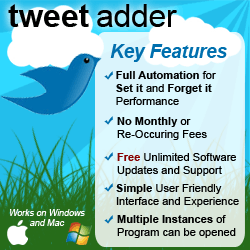Social Media Glossary
 A to Z of Social Media Terms
A to Z of Social Media Terms
Are you confused with all of the buzz-words that surround Social Media and Social Networking? Don’t know your podcasting from your vodcasting?
Ever wondered the meaning of Search Engine Optimisation? And what exactly is a vlog? Or blogging? Or the blogosphere?
Fret no more! Here for the first time, in my wonderfully simplified Social Media Glossary are my definitions for all the latest social media buzzwords doing their rounds.
Did I miss something? CLICK HERE to tell me about the missing social media term and I’ll add it.
A-D | E-H | I-L | M-P | Q-T | U-Z
Advanced Audio Coding
(also MPEG-2 AAC): An audio compression scheme that is a continuation of the MP3 CODEC, but uses better filtering methods, noise shaping and quantization resolution to produce higher-quality audio files at smaller bit rates. AAC is designed for use in digital broadcasting systems as well as for multi-channel and surround audio (such as 5.1), and based on its capability to support up to 96kHz sampling rates and 48 channels [including LFE], AAC could be the basis for audio in multimedia for the foreseeable future. Some streaming audio formats that have adopted the AAC scheme already are Liquid Audio (.lqt), AT&T’s already fading .a2b format, and the soon-to-be-realized MP4 format.
Adverblog
Short for “advertising blog,” a blog used purely for advertising purposes.
Aggregation
Aggregation is the process of gathering and remixing content from blogs and other websites that provide RSS feeds. The results may be displayed in an aggregator website like Bloglines or Google Reader, or directly on your desktop using software often also called a newsreader.
Aggregator
A site, such as Bloglines or Google Reader, that displays information related to user-specified keywords. The information is gathered and remixed from multiple websites via RSS feeds. Also, the name given the software, often free, that automatically gathers the RSS-based summaries of a set of user-based blogs or sources for easy browsing.
AJAX
An acronym standing for Asynchronous JavaScript and XML. This is a web development technique for creating interactive web applications. By shifting a great deal of computation to the web surfer’s computer, web pages don’t have to reload when a change is made due to user interaction. Ajax can increase the web page’s interactivity, speed, and usability.
Alerts
Search engines allow you to specify words, phrases or tags that you want checked periodically, with results of those searches returned to you by email. You may also be able to read the searches by RSS feed. This form of search allows you to check whether you, your organisation, your blog or blog item has been mentioned elsewhere, and so to respond if you wish.
Architecture Of Participation
A phrase coined by open source media advocate Tim O’Reily, used to describe the nature of systems created for user contribution, such as Wikipedia. The phrase has come to define one of the key elements of what’s been called Web 2.0, describing the collection of companies, technologies and projects that are designed around the culture and economics of openness.
Archive
May refer to topics from an online discussion that has been closed but saved for later reference. On blogs, archives are collections of earlier items usually organised by week or month. You may still be able to comment on archived items.
Astroturfing
This describes a supposed grass-roots social site which is actually supported by some powerful organization “private or public” with an agenda.
Asynchronous Communications
Online communications independent of time or place, such as email lists, bulletin boards and forums. Messages go to and fro rather than appearing in one place nearly simultaneously (synchronous communication).
Audio Blog
Another name for a podcast. Despite the casual nature implied by the word blog in this term, audio blogs can have a wide range of production values from very casual audio journals to professionally produced shows including music, sound effects and other production values.
Audio Boo
Is a website and mobile device application designed to allow users to post and share sound files on the AudioBoo website. AudioBoo was developed by UK based BestBefore, partially funded by Channel 4 and was launched in March 2009
Audio On-Demand
Another expression for audio podcasting, referencing the ability of listeners to start, stop, replay and skip sections or whole recordings at any time, virtually any place in their daily lives. See Podcast and Time-shifting.
Authenticity
The sense that something or someone is “real”. Blogs enable people to publish content, and engage in conversations, that show their interests and values, and so help them develop an authentic voice online.
Avatar
A graphical image representing a person. They are what you are in virtual worlds. You can build a visual character with the body, clothes, behaviours, gender and name of your choice. This may or may not be an authentic representation of yourself.
Bed
Audio that is reused as a background element, such as music or effects in radio, television, video or podcasts.
Back channel
Communications which are private emails or other messages sent by the facilitator or between individuals during public conferencing. They can have a significant influence on the outcomes of public conversations.
Blegging:
Derived from blog and beg, this term means to send a query through the blogosphere in search of an answer.
Blog
Shortened from the original term Weblogs these self-published websites containing dated material, are usually written in a journal format. Content such as text, pictures, video and/or audio have URLs plus other ways of identifying them by keywords (tags). This allows visitors to pull items to their desktop through subscriptions or aggregators without having to visit the actual website. Blogs often have links to other relevant online content, plus invite feedback through “posts” which are comments from readers.
Blogs and Blogging
The word blog is a contraction of the term Web log and is a web site of commentaries, or postings, on a particular subject and may include events, graphics and videos. Blogs can be personal or corporate but are usually maintained by one individual and include a signature and picture. Common blog tools include SuperBlogs, Blogger, Type Pad, and WordPress.org.
Blogcast
Another name for a podcast.
Blogerati or Blogophiles
Two terms used to describe sophisticated blog authors and readers.
Blogosphere
The term used to describe the totality of blogs on the Internet, and the conversations taking place within that sphere. i.e. “The universe of blogging and bloggers.”
Blogroll
A list of sites displayed in the sidebar of blog, showing who the blogger reads regularly.
Bookmarking
Saving the address of a website or item of content, either in your browser, or on a social bookmarking site like Delicious. If you add tags, others can easily use your research too, and the social bookmarking site becomes an enormous public library. If groups agree the tags they’ll use, it makes collaborative research much easier.
Bookmarklets
Also called favelets, these are free tools to help with repetitive, difficult and/or time-consuming tasks when using a web browser.
Browser
The tool used to view websites, and access all the content available there onscreen or by downloading. Browsers may also have features including the ability to read feeds, write blog items, view and upload photos to photosharing sites. Browsers have become the central tool for using social media as more and more tools previously used on our desktops are becoming free online.
Bulletin boards
Were the early vehicles for online collaboration, where users connected with a central computer to post and read email-like messages. They were the electronic equivalent of public notice boards. The term is still used for forums.
Business-Class Podcast
A term to describe podcasts directed toward a professional audience. Business-class podcasts can be casual in nature, although typically don’t have the garage-band feel or outreach that more lifestyle podcasts have. Lifestyle podcasting or trendy casts are generally targeted at the youth market, and have little long-term branding goals.
Buzz
Online chatter or social discussion and interaction characterised by frequent expressed interest and/or mentions of a subject among the online community.
Categories
Pre-specified ways to organise content – for example, a set of keywords that you can use but not add to when posting on a site. They form part of a taxonomy.
Champions
In order to get conversations started in an online community, you need a group of enthusiasts willing and confident to get things moving by posting messages, responding, and helping others.
Channel
A group of podcast (or video-cast) items, each of which represents one MP3 audio file (or show). When subscribing to podcasts, it is the channel you subscribe to.
Chat
The interaction on a web site, with a number of people adding text items one after the other into the same space at (almost) the same time. A place for chat – chat room – differs from a forum because conversations happen in “real time”, rather as they do face to face.
Chat Room
A designated online location for chat to take place. Unlike forums, chat room conversations are real-time exchanges.
Chicklet
Nickname for the small buttons used as links to RSS files (usually orange with a graphic resembling waves or ripples expanding out). Many podcatchers allow you to drag chicklets onto them to quickly add a subscription.
Clodpasting
A lame attempt to use online audio programming to launch a career into show business. Noun: clodpast, a poorly conceived and/or executed digitally broadcast audio message.
Collaboration
Social media tools from email lists to virtual worlds offer enormous scope for collaboration. Low-risk activities like commenting, social bookmarking, chatting and blogging help develop the trust necessary for collaboration.
At greater length: Collaboration is one of the higher goals of social networking – being able to discuss and work with people across boundaries of organisation, time and space. The tools to achieve this extend from email with attachments through web-based workspaces with messaging, file storage, calendars and other tools. With the right equipment and connections you can talk to and see each other, text, sketch and transfer files almost instantly. You can set up a workspace in a virtual world, and collaborate with other avatars. However, the conditions for successful collaboration are more human and cultural than technical, with the bottom line being trust. Bloggers maintain that the conversational and authentic tone of the medium helps create conditions for collaboration. Sharing, commenting, chatting, co-authoring allow low-risk explorations of who you would feel comfortable working with.
Collaborative Consumption
A business model in which goods or services are shared, swapped, or rented over networks. Websites like Airbnb, a platform for short term home rentals, and OurGoods, a bartering network for the creative community, have changed the way that we look at the traditional e-commerce model.?
Collective intelligence
Defined by George Pór as the capacity of a human community to evolve toward higher order complexity thought, problem-solving and integration through collaboration and innovation. For a network to develop this “mind of its own” there needs to be a willingness among members to share and collaborate. Collective intelligence is not the same as the Wisdom of Crowds, where individual preferences and decisions may aggregate to produce better results without people consciously collaborating. The latter is more market oriented, the former more cooperative.
Comments
Blogs often allow readers to add comments under items, and may also provide a feed for comments as well as for main items. That mean you can keep up with conversations without having to revisit the site to check whether anything has been added.
Commitment
The “social” aspect of social media means that tools are most useful when other people commit to using them too. Commitment will depend on people’s degree of interest in a subject, capability online, preparedness to share with others, degree of comfort in a new place, as well as the usability of the site or tool. If people are passionate about a subject and desperate to share and research, they will usually clamber over technical problems. But making things technically easier – while desirable – won’t usually gain people’s commitment on its own.
Communities
Groups of people that connect using social networking technologies. The people in these communities often have common demographics and psychographics in addition to a common interest that pulls them together.
Community building
The process of recruiting potential community or network participants, helping them to find shared interests and goals, use the technology, and develop useful conversations. A number of different roles may be involved.
Communitainment
Coined by investment bank firm, Piper Jaffray, this term describes a trend involving consumers moving communication beyond a mere exchange of information to facilitate an exchange of content, ideas, and entertainment within an online social context.
Compensated Consumer-Generated Media (CCGM)
This is media where marketers pay consumers to do certain things, or when publishers compensate artists or content creators for submissions frequently based on their popularity, i.e. number of unique hits.
Connection
A connection is someone who is a user that is directly connected with another. As an example, you add connections with people you know in the LinkedIn user network to build your personal LinkedIn network.
Connections
As high-speed, always-on, broadband connections becomes more widely available, it is easy to forget that the speed and nature of Internet connection available to people on a network will determine what tools they can use. If people are still using slow telephone dialup they may have problems with video and voice over IP. If they don’t have an always-on connection, Web-based tools will be less appealing because work on them can only be done when connected.
Consumer-Generated Media (CGM)
First-person commentary posted or shared across a host of expression venues, including message boards, forums, rating and review sites, groups, social networking sites, blogs, video-sharing sites, etc.
Consumer-Generated Multimedia (CGM2)
Consumer created sight, sound, and motion components posted online using sites such as YouTube, MySpace, iTunes, etc.
Consumer-Fortified Media (CFM)
Advertiser created digital media that is shaped and promoted by consumers through online commentary and debate.
Consumer-Solicited Media (CSM)
Often called “co-creation” or “participator advertising” CSM involves an online advertiser who provides a format and invites visitors to add their content. Examples include “create your own 30 second commercial”, “upload your sponsor-relevant photo or video” or “send us your best recorded memory of how our brand impacted your life.”
Content
Used here to describe text, pictures, video and any other meaningful material that is on the Internet.
Content management systems (CMS)
Sometimes described as the Swiss Army knives of social media. They are software suites offering the ability to create static web pages, document stores, blog, wikis, and other tools. CMSs have the advantage of offering comprehensive solutions – but can be challenging to configure, and each of the different tools may not be quite as good as a stand-along version. Unless you have some technical skills, they are best suited for situations where you can employ a web developer to work with you, and provide some continuing support.
Control
Social networking is difficult to control because if people can’t say something in one place they can blog or comment elsewhere. That can be challenging for hierarchical organisations used to centrally-managed websites.
Conversation
Through blogging, commenting or contributing to forums is the currency of social networking. At more length: A popular perception of bloggers is of people ranting on a virtual soapbox without knowing who is listening. While that may be true for some, the real rewards of blogging come from exchanges with others. Every blogger needs an audience – and preferably one adding comments. Even better if another blogger picks up your item, adds a link and a little interpretation, publishes on their site, and puts a trackback to yours. That way you pick up readers coming in from the other site, and know from the trackback you have someone with whom to start a conversation. Even if there isn’t a trackback, you can set up searches to alert you when someone mentions your name, site or conversation thread on the Net.
Copyright
Sharing through social media is enhanced by attaching a Creative Commons license specifying, for example, that content may be re-used with attribution, provided that a similar license is then attached by the new author. At more length: In the spirit of openness and sharing generally prevalent among social networkers, you will often find content labelled with a copyright license that allows you to re-use the material provided you provide an attribution. The Creative Commons site offers different licenses. One frequently used is Attribution-Share Alike, whereby you can alter and re-use the content provided you then add the same license. This may not appeal to people or organisations who like substantial control. Again, it is partly a cultural and personal issue, rather than a technical one.
Creative Commons License (CCL)
A copyright license that spells out how proprietary online content can be shared, reused or altered.
Crowd funding or crowdfunding
(alternately crowd financing, equity crowdfunding, or hyper funding) describes the collective effort of individuals who network and pool their money, usually via the Internet, to support efforts initiated by other people or organisations. Crowd funding is used in support of a wide variety of activities, including disaster relief, citizen journalism, support of artists by fans, political campaigns, startup company funding, movie or free software development, inventions development and scientific research.
Crowd funding can also refer to the funding of a company by selling small amounts of equity to many investors. This form of crowd funding has recently received attention from policymakers in the United States with direct mention in the JOBS Act; legislation that allows for a wider pool of small investors with fewer restrictions.
Crowd Sourcing or Crowdsourcing
Refers to harnessing the skills and enthusiasm of those outside an organisation who are prepared to volunteer their time contributing content and solving problems. An example of a crowdsourcing service would be Amazon Mechanical Turk
Culture
Social media only works well in a culture of openness, where people are prepared to share. For that reason, commitment and attitude are as important as tools. Creative two-way communication and collaboration is unlikely to flourish in an organisation where the norm is top-down control. When people in that sort of culture talk about networking they may have a hub and spokes model in mind, with them having some central control.
Cyberspace
Widely used as a general term for the Internet or World Wide Web. More recently blogosphere has emerged as a term for interconnected blogs.
Default
In computing, refers to the settings on any device that come “out of the box”. It may be used loosely to suggest “lowest common” … so when trying to set up ways of collaborating online you may hear reference to email-with-attachments as the default. The challenge in social networking is that you may need to move from default mode to something customised to your requirements.
Democracy
Social networking and media are potentially attractive to those who want to revive representative democracy, and those who promote participative approaches … or both. Social media offers politicians and their constituents another communication channel. It also offers a wide range of methods for people to discuss, deliberate and take action.
Directory
There are dozens of directories listing podcasts, serving as vertical search engines for podcasts; examples include iTunes, Yahoo! Podcast, Podcast Alley, Singing Fish, Podcast Pickle, etc.
Download
To retrieve a file or other content from an Internet site to your computer or other device. See Upload.
Download Fraud
In a pay-per-download podcast advertising model, there is the possibility that someone could maliciously download a podcast to get advertising fees.
A-D | E-H | I-L | M-P | Q-T | U-Z
Social Media Glossary Appendix:
Sources:
- www.en.wikipedia.org
- www.netlingo.com
- www.google-kai.com/social-networking-glossary.html
- www.socialmedia.wikispaces.com/A-Z+of+social+media
- www.duranos.com/resources/web-glossary/
- www.fullcirc.com/weblog/2006/08/updating-my-online-interaction.htm
- www.problogger.net/archives/2006/06/27/a-z-of-professional-blogging/
- www.slideshare.net/travelinlibrarian/tech-terms
- www.digitaldialogues.org.uk/interimreport/glossary






